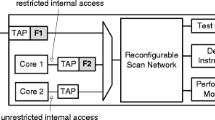Abstract
This paper presents a methodology to insert scan paths in a design that is specified on the Register Transfer Level (RT-Level). The results indicate that selecting registers on this level guarantees a reduction in DFT design time and improvement of fault coverage, without incurring high hardware overhead.
Similar content being viewed by others
References
M. Abramovici, J. Kulikowski, and R.K. Roy, “The Best Flip-Flops to Scan,” in Proc.International Test Conference, 1991, pp. 166–172.
V. Agrawal, “Sampling Techniques for Determining Fault Coverage in LSI Circuits,” Journal of Digital Systems, vol. V, pp. 189–202, 1981.
V. Agrawal, K. Cheng, D. Johnson, and T. Lin, “A Complete Solution to the Partial Scan Problem,” in Proc. of the International. Test Conf, 1987, pp. 44–51.
V.D. Agrawal, K.T. Cheng, D.D. Johnson, and T. Lin, “Designing Circuits with Partial Scan,” IEEE Design and Test of Computers, vol. 5, pp. 8–15, April 1988.
P. Ashar and S. Malik, “Implicit Computation of Minimum-Cost Feedback-Vertex Sets for Partial Scan and Other Applications,” in 31st ACM/IEEE Design Automation Conference, 1994, pp. 77–80.
S. Bhawmik, C. Lin, K. Cheng, and V. Agrawal, “PASCANT: A Partial Scan and Test Generation System,” in Proc. Of the Custom Integrated Circuits Conference, 1991, pp. 17.3.1–17.3.4.
S.T. Chakradhar, A. Balakrishnan, and V. D. Agrawal, “An Exact Algorithm for Selecting Partial Scan Flip-Flops,” in Proc. of the 31ts ACM/IEEE Design Automation Conference, 1994, pp. 81–86.
Chau-Shen Chen and TingTing Hwang, “Layout Driven Selection and Chaining of Partial Scan Flip-flops,” Journal of Electronic Testing, vol. 12, no. 1/2, pp. 19–27, 1998.
K.T. Cheng and V.D. Agrawal, “An Economical Scan Design for Sequential Logic Test Generation,” in Proc. of Symposium on Fault Tolerant Computing, June 1989, pp. 28–35.
K.T. Cheng and V.D. Agrawal, “A Partial Scan Method for Sequential Circuits with Feedback,” IEEE Transactions on Computers, vol. 39, no. 4, pp. 544–548, April 1990.
V. Chickermane and J.H. Patel, “A Fault Oriented Partial Scan Design Approach,” in Proc. of the International Test Conf. on Computer-Aided Design, 1991, pp. 400–403.
L.L. Day et al., “Test Methodology for a Microprocessor with Partial Scan,” in Proc. International Test Conf., 1998, pp. 708–716.
S. Dey, A. Raghunathan, and K. Wagner, “Design for Testability at the Behavioral and Register-Transfer Levels,” Journal of Electronic Testing, vol. 12, no. 1/2, pp. 79–91, 1998.
V. Fernandez and P. Sanchez, “Partial Scan High-Level Synthesis,” Journal of Electronic Testing, 1996, pp. 481–485.
M.R. Garey and D.S. Johnson, Computers and Intractability: A Guide to the Theory of NP-Completeness, San Francisco: W. H. Freeman, 1979.
B. Greene and S. Mourad, “Partial Scan: Hardware Fault Coverage Trade-Off,” in Proc. International Measurement and Technology Conf., May 1998, pp. 423–427.
B. Greene and S. Mourad, “Partial Scan on RT-Level,” in Proc. WRTL, Nara, Japan, Nov. 2001, pp. 18–27.
R. Gupta, R. Gupta, and M.A. Breuer, “BALLAST: A Methodology for Partial Scan Design,” in Digest of Papers of the 9th International Symposium on Fault-Tolerant Computing, 1989, pp. 118–125.
Yu Huang, Chien-Chung Tsai, N. Mukherjee, O. Samman, D. Devries, Cheng Wu-Tung, and S.M. Reddy, “On RTL Scan Design,” in Proc. International Test Conf., 2001, pp. 728–737.
P. Kalla and M.J. Ciesielski, “A Comprehensive Approach to the Partial Scan Problem Using Implicit State Enumeration,” in Proc. International Test Conference, 1998, pp. 651–657.
R.M. Karp, in Reducibility Between Combinatorial Problems, Complexity of Computer Computations, R. Miller and J. Thatcher (Eds.), New York: Plenum Press, 1972, pp. 85–103.
D.H. Lee and S.M. Reddy, “On Determining Scan Flip-Flops in Partial-Scan Designs,” in Proc. International Conference on CAD, Nov. 1990, pp. 322–325.
H.K.T. Ma, S. Devadas, A.R. Newton, and A. Sangiovanni-Vincentelli, “An Incomplete Scan Design Approach to Test Generation for Sequential Machines,” in Proc. of the Proc. of the International. Test Conf., 1988, pp. 730–734.
A. Miczo, Digital Logic Testing and Simulation, NewYork: John Wiley & Sons, 1986.
T. Orenstein, Z. Kohavi, and I. Pomeranz, “An Optimal Algorithm for Cycle Breaking in Directed Graphs,” Journal of Electronic Testing, vol. 7, no. 1, pp. 71–81, 1995.
P.S. Parikh and M. Abramovici, “A Cost Based Approach to Partial Scan,” in Proc. of the 30th ACM/IEEE Design Automation Conference, June 1993.
S. Park and S. Akers, “A Graph Theoretic Approach to Partial Scan Design by K-Cycle Elimination,” in Proc. International Test Conference, 1992, pp. 303–311.
J. Rearick, “The Case for Partial Scan,” in Proc. International Test Conference, 1997, p. 1032.
S. Roy, G. Guner, and C. Kwang-Ting, “Efficient Test Mode Selection and Insertion for RTL-BIST,” in Proc. International Test Conf., 2000, pp. 263–272.
J. Savir, “Good Controllability and Observability Do Not Guarantee Good Testability,” IEEE Trans. on Computers, vol. C-32, no. 12, pp. 198–1200, Dec. 1983.
J. Steensma, F. Catthoor, and H. De Man, “Partial Scan at the Register-Transfer Level,” in Proc. International Test Conference, 1993, pp. 488–497.
Syntest Technologies, Inc., Test Pattern Generator and Fault Simulator, Sunnyvale CA.
S. Tai and D. Bhattacharya, “A Three-Stage Partial Scan Design Method using the Sequential Circuit Flow Graph,” in Proc. 7th International Conference on VLSI Design, 1994, pp. 101–106.
E. Trischler, “Incomplete Scan Path with an AutomaticTest Generation Methodology,” in Proc. of the International Test Conf., 1980, pp. 153–162.
M.J.Y. Williams and J.B. Angell, “Enhanced Testability of Large Scale Integrated Circuits via Test Points and Additional Logic,” IEEE Trans. Computers, vol. C-22, no. 1, pp. 46–60, 1973.
Author information
Authors and Affiliations
Rights and permissions
About this article
Cite this article
Greene, B.S., Mourad, S. Partial Scan Testing on the Register-Transfer Level. Journal of Electronic Testing 18, 613–626 (2002). https://doi.org/10.1023/A:1020801123311
Issue Date:
DOI: https://doi.org/10.1023/A:1020801123311




